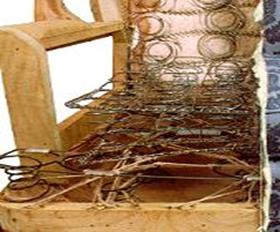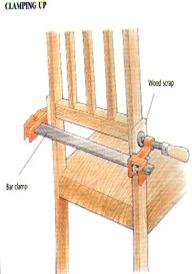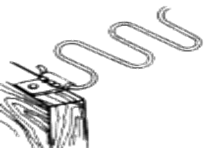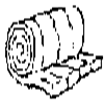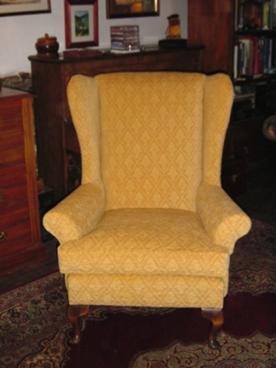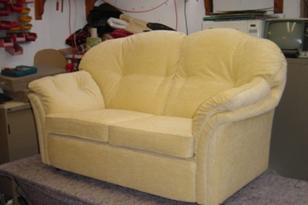|
By Mike Baldwin
Webbing
Webbing supports the springs of your sofa, or upholstered armchair.
If it's worn out, the upholsterer replaces it, using one of three
kinds: Nylon, which is serviceable and least expensive but not the
longest wearing. Jute, an imported fibre from India preferred for
quality and strength. And polyester, the latest in use and said to
be very long lasting.
Webbing comes in strips about 3½ inches wide and it's stretched
across the deck (or frame) and woven back and forth like the reed
strips in a basket. Webbing is also put on chair seats that have
pads and no springs. It is also put on seats and backs of fully
upholstered chairs.
Hand-Tied Springs
The 8-way hand-tied spring is a mark of quality and a byword in
industry parlance. But the consumer can be somewhat mystified and is
apt to respond with, "It sounds good but what does it mean?" It
means you'll never be sorry.
Coil Springs
The 8-way hand-tie uses a coil spring which is the strongest, most
resilient, flexible and longest lasting. It practically never gives
out, although a coil or two may give up and come loose or break.
tieing Process
To refurbish springs, the upholsterer re-attaches loose springs,
replaces any if necessary, and re-ties the entire set, one by one.
Each coil is sewn to the webbing (or attached with a metal clip),
then tied to the coil next to it. Each row of coils is then tied
front to back, side to side, and diagonally two ways, 8 in all. And
all are tied on exactly the same level to make a symmetrical, even
suspension for the most comfortable seating.
Different Degrees of Suspension
This smooth meadow of springs can be tied at different levels for
different degrees of firmness. The more they are pulled down, the
firmer the seating. Firm, medium-firm, or hard, the hand-tied coil
spring will always have g-i-v-e.
Zigzag Springs
Zigzag springs are also hand-tied. They are an S-shape, simpler in
construction, and are used in frames that take stresses differently
and for which they are more appropriate. They have come into use
more recently than the coil spring, and are differently attached to
the frame, with clips.
Fillings
Fillings provide the comfort on seats and backs of upholstered
furniture, and also influence the shaping. They vary from down,
which gives a rich, plush softness–to hair blends for the firmest
seating's.
Down
Now that full, plump cushions and seating's are in fashion, down is
used alone in matching pillows, and in combination with other fibres
for the seating, as with a mix of rubber for smoothness and
resilience. Down is the most expensive filling. It is seductively
soft and is the traditional luxury filling.
Fluffy Polyester
Made in rolls of varying thicknesses, Polyester can be used alone or
as a wrapping for polyfoam. Provides a smooth, rounded and soft
cushion and is an excellent contemporary filling. Used with all
styles of furniture.
Polyurethane Foam
Polyurethane foam is a popular and reliable material that does a
good job at shaping and stuffing, and comes in different densities
for different degrees of firmness: Soft, Medium, Super Resilient
(SR), Firm, Extra Firm and High Resiliency (HR) for the most firm.
Newer foams belonging the the High Resilience (HR) family offer a
soft, initial feel and then firm up as more pressure is put on it...
Yielding very comfortable and supportive seating.
Hair Blends
Firmest of all, is hair. This used to be horsehair, the kind that
plumped up the old Victorian sofa on which the properties of sitting
stiffly on an unyielding surface were the manners of the day. Today,
the filling is more flexible and inviting, and it's hogs-hair or
cattle hair mixed with other fibers for a kindlier feel and better
resilience. It gives first-class firmness and has a long, sturdy
life with plenty of comfort and bounce.
Choosing
Fillings are also chosen by the upholsterer according to the style
of the piece. If it's tightly tailored, even though the cushioning
is thick, a firmer filling will be used. If the style takes lots of
tucking and draping, has soft, loose cushions, and you want both the
appearance and the sensation of deep-down softness, a fluffier
filling is used. You can talk this over with your upholsterer who
will advise you, but the ultimate decision is yours. You're the one
who's going to sit on it, and personal preference has the last word.
Also, these materials vary in price so it's nice to know what you
are getting and what you are paying for.
Padding
Padding is the material that goes on directly under your upholstery
fabric. Its function is to fill out and firm up the contours of the
sofa or chair (fully upholstered) so that the fabric sits smoothly
and fits perfectly all around, without wrinkles or puckers.
Padding also acts as a buffer along the arms and back of a piece
where friction and wear show up first, as on corners and edges.
Cotton padding is considered the best because it wears long. The
cotton is mixed with a bit of felt and fabricated in rolls. These
come in different grades and a thickness of about 1¾" is considered
a good padding. Polyester fibrefill is also currently being used as
a padding and is providing excellent results.
Fabrics: Finishing a Piece With a Flourish
Everyone visualizes the transforming effect of the fabric on a
re-created sofa or chair. As one young homemaker put it, the fabric
"is part of the fun" of reupholstering. Fabric has character and
personality. It speaks for your taste, your style. And in your own
home, it can be as personal and individual as your signature.
The Fabric Advantage in Re-upholstery
Fabric is also one of the two big costs in Re-upholstery (the other
is labour). So it's important to get good value as well as good
fashion. The bigger the choice, the better the chance of finding a
fabric that suits both your decor and your budget. This is where
Re-upholstery gives you the benefit of rich variety and enormous
volume. The selection is practically endless.
A World of Choice
Big reupholstering firms can offer a thousand samples, imported and
domestic. Smaller shops carry hundreds. All in different grades of
quality. You can wind up with a good decorator fabric, which, when
figured into the total cost of a reupholstering job, comes to
considerably less than today's price for an expensive piece of
upholstered furniture.
Wear Quality
How do you judge for wear? A classic standard applies here, as used
by the professionals: "The tighter the weave, the longer the wear."
The standard is threads to the inch. One square inch of fabric with
8 or 10 thick threads doesn't have the strength of one square inch
densely packed with 30 to 40 thin threads. Specifically: A woven
cotton tapestry, where the colours and pattern are tightly woven in
with coloured threads, wears better than a cotton with the colours
printed on. To check a fabric yourself, hold it up to the light. The
less light that shows through, the tighter the weave. A good
upholsterer will advise you also. He knows fabrics like the back of
his hand and can clue you in to textures and constructions.
Fibres and Blends
Fibres also make a difference in wear. Natural fibres, like cotton,
take colour differently from man-made fibres. They can be richer,
more subtle. While the man-mades have resilience and strength.
That's how the blends came into use. So cotton with polyester, for
example, gives you the best attributes of both. Other blends will
use nylon, acrylic, rayon. And man-made fibres alone (far advanced
over the earlier versions) make many attractive long wearing pieces.
Texture Types
The appearance of certain textures will vary with use. Fabrics with
a nap, like velvets and corduroys, look different in different
lights, and show wear where they've been sat upon. Silks are more
delicate, but many are fortified with a man-made fibre. And fabrics
with highly textured surfaces, like loopy tweeds and homespun's can
"pull" after a while. Flat weaves, like the cottons, damasks,
jacquards, and close-grained tightly ribbed cottons stand up well.
Soil Resistance & Clean ability
For clean ability, each fiber has its compensating feature. Natural
fibres absorb soil faster than man-made fibres, but clean better.
While man-made fibres are more soil resistant, but don't always
clean as well. Many fabrics are treated with soil-resistant
finishes, but the finish doesn't last forever, so be prepared after
a time, to have the upholstery cleaned.
|

